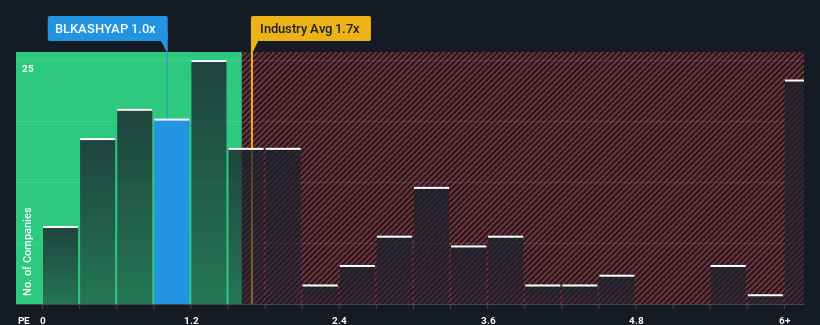- India
- /
- Construction
- /
- NSEI:BLKASHYAP
Revenues Working Against B.L. Kashyap and Sons Limited's (NSE:BLKASHYAP) Share Price Following 28% Dive
The B.L. Kashyap and Sons Limited (NSE:BLKASHYAP) share price has fared very poorly over the last month, falling by a substantial 28%. Instead of being rewarded, shareholders who have already held through the last twelve months are now sitting on a 29% share price drop.
Since its price has dipped substantially, B.L. Kashyap and Sons may be sending bullish signals at the moment with its price-to-sales (or "P/S") ratio of 1x, since almost half of all companies in the Construction industry in India have P/S ratios greater than 1.7x and even P/S higher than 4x are not unusual. Although, it's not wise to just take the P/S at face value as there may be an explanation why it's limited.
See our latest analysis for B.L. Kashyap and Sons

How Has B.L. Kashyap and Sons Performed Recently?
It looks like revenue growth has deserted B.L. Kashyap and Sons recently, which is not something to boast about. Perhaps the market believes the recent lacklustre revenue performance is a sign of future underperformance relative to industry peers, hurting the P/S. If not, then existing shareholders may be feeling optimistic about the future direction of the share price.
Although there are no analyst estimates available for B.L. Kashyap and Sons, take a look at this free data-rich visualisation to see how the company stacks up on earnings, revenue and cash flow.How Is B.L. Kashyap and Sons' Revenue Growth Trending?
In order to justify its P/S ratio, B.L. Kashyap and Sons would need to produce sluggish growth that's trailing the industry.
Taking a look back first, we see that there was hardly any revenue growth to speak of for the company over the past year. Fortunately, a few good years before that means that it was still able to grow revenue by 6.7% in total over the last three years. Therefore, it's fair to say that revenue growth has been inconsistent recently for the company.
This is in contrast to the rest of the industry, which is expected to grow by 13% over the next year, materially higher than the company's recent medium-term annualised growth rates.
In light of this, it's understandable that B.L. Kashyap and Sons' P/S sits below the majority of other companies. Apparently many shareholders weren't comfortable holding on to something they believe will continue to trail the wider industry.
The Key Takeaway
B.L. Kashyap and Sons' P/S has taken a dip along with its share price. Generally, our preference is to limit the use of the price-to-sales ratio to establishing what the market thinks about the overall health of a company.
Our examination of B.L. Kashyap and Sons confirms that the company's revenue trends over the past three-year years are a key factor in its low price-to-sales ratio, as we suspected, given they fall short of current industry expectations. Right now shareholders are accepting the low P/S as they concede future revenue probably won't provide any pleasant surprises. Unless the recent medium-term conditions improve, they will continue to form a barrier for the share price around these levels.
There are also other vital risk factors to consider before investing and we've discovered 1 warning sign for B.L. Kashyap and Sons that you should be aware of.
If companies with solid past earnings growth is up your alley, you may wish to see this free collection of other companies with strong earnings growth and low P/E ratios.
Valuation is complex, but we're here to simplify it.
Discover if B.L. Kashyap and Sons might be undervalued or overvalued with our detailed analysis, featuring fair value estimates, potential risks, dividends, insider trades, and its financial condition.
Access Free AnalysisHave feedback on this article? Concerned about the content? Get in touch with us directly. Alternatively, email editorial-team (at) simplywallst.com.
This article by Simply Wall St is general in nature. We provide commentary based on historical data and analyst forecasts only using an unbiased methodology and our articles are not intended to be financial advice. It does not constitute a recommendation to buy or sell any stock, and does not take account of your objectives, or your financial situation. We aim to bring you long-term focused analysis driven by fundamental data. Note that our analysis may not factor in the latest price-sensitive company announcements or qualitative material. Simply Wall St has no position in any stocks mentioned.
About NSEI:BLKASHYAP
B.L. Kashyap and Sons
Engages in the construction and infrastructure development activities in India.
Adequate balance sheet with low risk.
Similar Companies
Market Insights
Community Narratives



